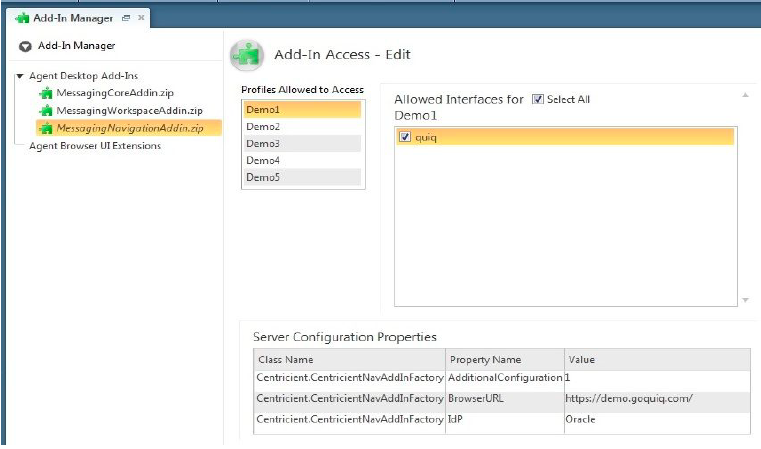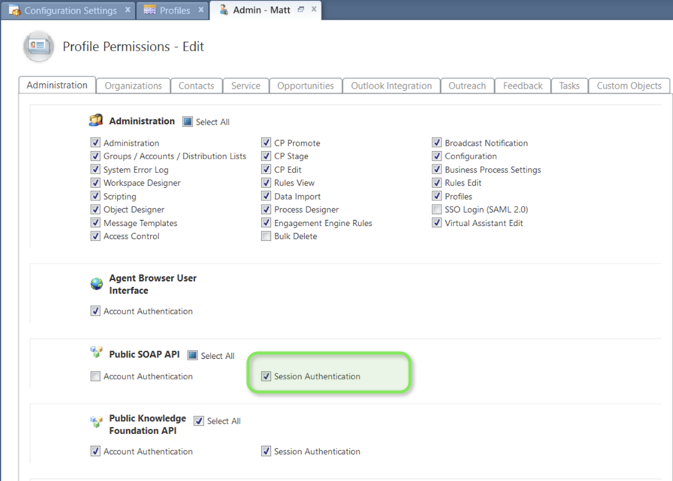Add-in Configuration (OSC)
Oracle Service Cloud Add-in Configuration
Obtaining The Files
Quiq add-ins are updated as changes warrant. The latest versions are typically recommended as they will contain the most features and improvements. There are three add-in files required for the Quiq integration and these may be downloaded via the following links:
Installation
Quiq Messaging Core
The Quiq Messaging Core Add-in is ~52MB in size. To successfully upload and install this add-in file, it is necessary to set the FATTACH_MAX_SIZE configuration large enough to accommodate the file.
-
The FATTACH_MAX_SIZE config under Site Configuration -> Configuration Base should be set to 60000000 or greater.
-
Navigate to Site Configuration > Add-in Manager. Add a new Agent Desktop Add-in. Ensure that ‘Compressed Add-In Files (*.zip)’ is listed in the file type, then select MessagingCoreAddin.zip and click Open. Configure access to the add-in.
-
Click the Profile Access button and select the profiles which will require access to the Quiq applications.
-
Ensure the profile of the integration account is included. Also select the interfaces that will be using Quiq.
-
Save the add-in and note that the save process will take some time while the file is uploaded.
NoteMany OSC instances have an issue where the php.ini file is not updated after the FATTACH_MAX_SIZE setting is updated. This will be evidenced by the the Messaging Core add-in not appearing in the list after saving. If this occurs, open a ticket with Oracle Support and provide the information above to have the issue corrected.
Quiq Navigation Pane
-
Again, navigate to Site Configuration > Add-in Manager. Add a new Agent Desktop Add-in. Ensure that ‘Compressed Add-In Files (*.zip)’ is listed in the file type, then select MessagingNavigationAddin.zip and click Open. Configure access to the add-in.
-
Click the Profile Access button and select the profiles which will require access to the Quiq applications. Ensure the profile of the integration account is included. Also select the interfaces that will be using Quiq.
-
REDUNDANT CONFIGURATION SETTINGS For each profile and interface granted access to the add-in, in the ‘Server Configuration Properties’ grid at the bottom, click in the ‘Value’ cell for the second row (the row with ‘Property Name’ = ‘BrowserURL’), and enter the URL for the Quiq tenant (e.g. https://companyname.goquiq.com).
-
Enter ‘Oracle’ in the ‘Value’ cell of the third row (the row with ‘Property Name’ = ‘IdP’). Enter ‘1’ in the ‘Value’ cell for the first row in the grid (the row with ‘Property Name’ = ‘AdditionalConfiguration’). Click out of the grid and save the add-in.

SINGLE CONFIGURATION SETTINGS Open the Configuration Settings editor in OSC. Create a new Site level Text custom configuration named CUSTOM_CFG_QUIQ_BOOTSTRAP under the Custom folder with the following settings:
- Key: CUSTOM_CFG_QUIQ_BOOTSTRAP (this is the required Key value for the Configuration Setting)
- Type: Site
- Maximum Length: 10000
- Site Value: { "BrowserUrl": "https://companyname.goquiq.com/", "IdP": "Oracle", "AdditionalConfiguration": "1" }
Ensure the Session Authentication permission under Public SOAP API is enabled on all profiles that need to access the Quiq Add-ins.

Quiq Workspace Add-in
-
Navigate to Site Configuration > Add-in Manager. Add a new Agent Desktop Add-in. Ensure that ‘Compressed Add-In Files (*.zip)’ is listed in the file type, then select MessagingWorkspaceAddin.zip and click Open. Configure access to the add-in.
-
Click the Profile Access button and select the profiles which will require access to the Quiq applications. Ensure the profile of the integration account is included. Also select the interfaces that will be using Quiq.
Updated about 2 months ago
